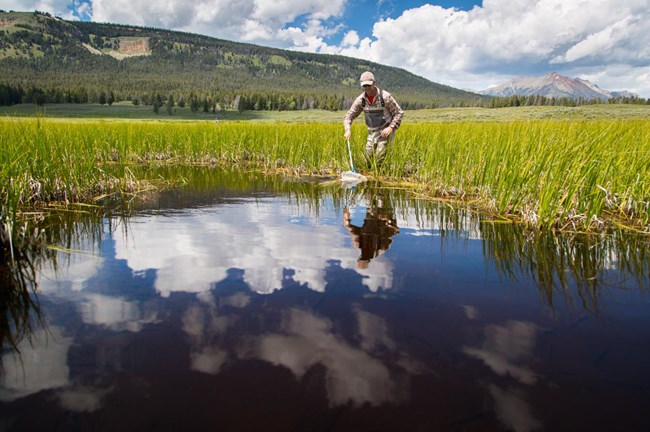Last updated: January 27, 2022
Article
Scientist Profile: Andrew Ray, Ecologist

NPS
From one generation to another
“I was fortunate enough to grow up in a household where my father was a naturalist. He didn't do it as a profession but as a passion, and he was particularly interested in plants and birds. At a very early age, I learned how to identify different bird and plant species. Those early experiences made a real impact on me. Even to this day, I would argue that my father is a better natural historian than I am, even though he doesn't have formal training. He still offers today, even though I'm a trained and paid ecologist, the kind of patience and careful description of things that I only hope I can share someday with my son.
“I started out University focused on having fun, but as I got closer to graduation I started developing a seriousness. I think the classes that resonated most with me were an aquatic botany class and a limnology class. I became interested in aquatic habitats, and wetland plants in particular. Those subjects gave me an opportunity to explore beneath the water’s surface in wetlands. I think the early experiences in my childhood set me up for an appreciation of nature, and then coursework during my undergraduate training showed me different habitats and the diversity in those places. That gave me a formal way to approach nature and environmental science, and to start asking questions.”
Working in Science Education and Ecology at Crater Lake National Park
“I started with the National Park Service working at Crater Lake National Park in Oregon. I had the opportunity to work at their Science and Learning Center. Lots of the bigger parks offer them. It’s a neat program: the students get an opportunity to experience Crater Lake through the eyes of a scientist and use the park as a living laboratory to explore ideas. It's a way for the parks to collaborate with both researchers and educators to inspire future stewards of the parks.”

“Then I moved over to the program that I'm in now, which is the Inventory & Monitoring Division. I think my favorite project is a long-term monitoring project following up on work I've done at Crater Lake. Crater Lake is a unique and iconic lake, but it's not unique in that it's been impacted by humans. Humans introduced fish into what was previously a fishless lake in the 1910s. Those fish didn't do well, mainly because it's such a nutrient poor lake. So, like many places, to keep the recreational opportunity alive, we humans introduced nonnative crayfish. Fast forward a few decades, and park biologists realized the crayfish were expanding around the perimeter of the lake and occupying the same habitats as this endemic salamander, the rough-skinned newt. It’s called the Mazama Newt (Taricha granulosa mazamae) in Crater Lake because Mount Mazama erupted and then collapsed to form the lake. This newt, which is thought to be unique to the area, was starting to decline along with the introduction and increase of the crayfish.
“The project that I've been working on for about a decade with other park biologists at Crater Lake is first describing the Mazama Newt: Is it in fact different than newts outside of Crater Lake? And then trying to understand the impacts of introduced crayfish into Crater Lake. How do we first characterize what's there, and then quantify the threats of introduced crayfish or climate change on this unique salamander? “
“I'm also involved in other cool projects in Yellowstone, Grand Teton, and Bighorn Canyon, but the Crater Lake project sticks out as one of my first park service experiences. I think the recipe for a good project is to work on something you care deeply about, and to work with people who you respect and value. That makes for something that's very rewarding.”

NPS
Appreciating what we have while keeping the future in mind
“In the US, we're blessed with open space and intact natural resources in many parts of the country. People get a chance to interact with nature, and students can experience the topics that they're learning about in class by going out in the field and exploring on their own or with their peers.
We can look at the National Park Service as an amazing model and experiment, to set aside these special places. People come from all over the world to see places like Yellowstone and Grand Teton National Park or the Grand Canyon. But what I worry about is how climate change is going to affect all these amazing places. Droughts are increasing, extreme weather events and fires in the western forested parks are increasing. We can be certain there are going to be effects on society as well. But even though we've protected these parks with boundaries, the effects of climate change extend across those boundaries. I am worried about what those possible effects are going to be on these very special places.”
“I'm so grateful to be able to explore the biodiversity of National Parks as part of my work—these are among the most special places on Earth, and they still hold surprises just waiting to be discovered.”
Interview and profile by Jeffrey Larooi, August 2020
Further Reading
Greater Yellowstone Inventory & Monitoring NetworkCrater Lake Science & Learning Center
